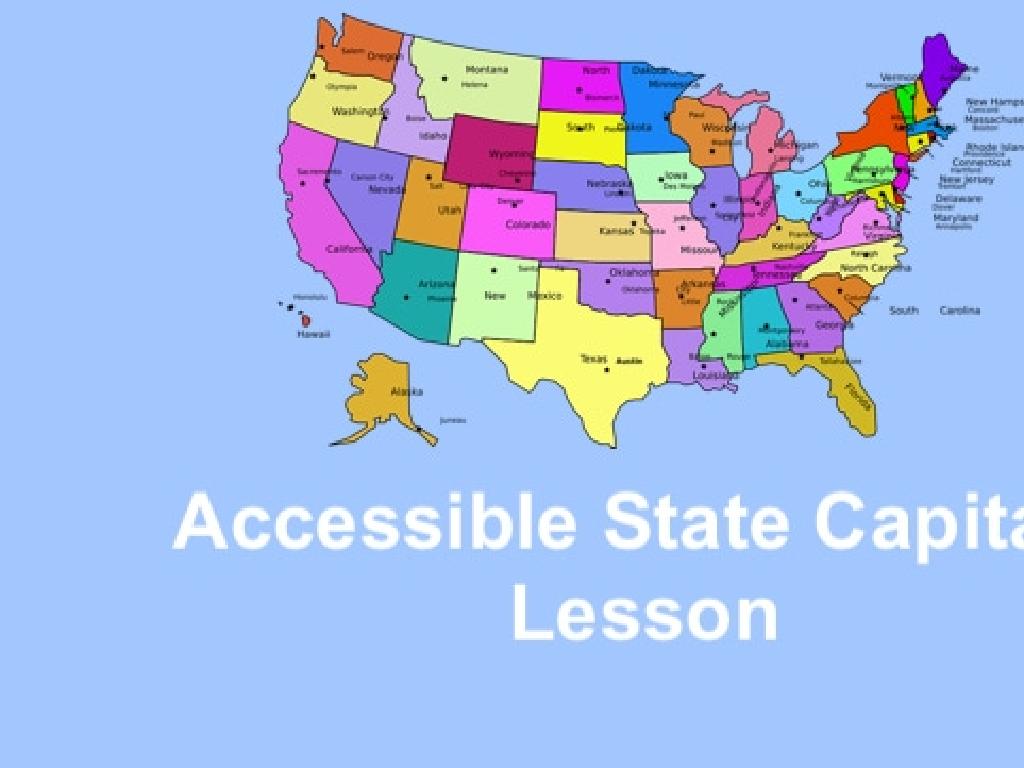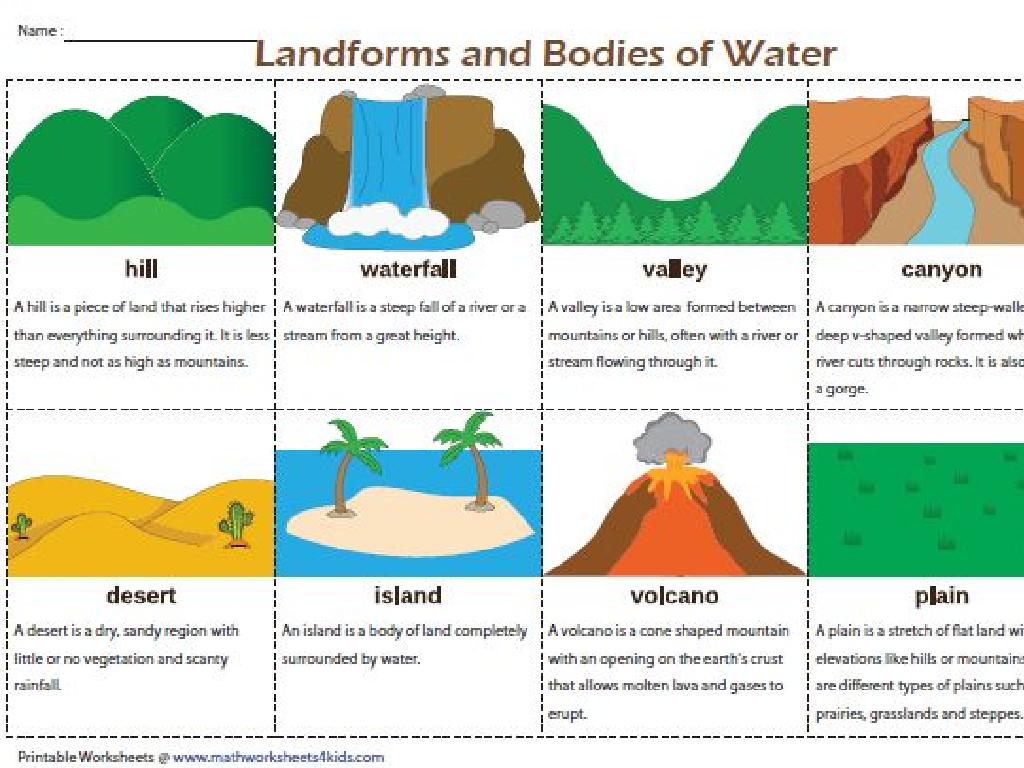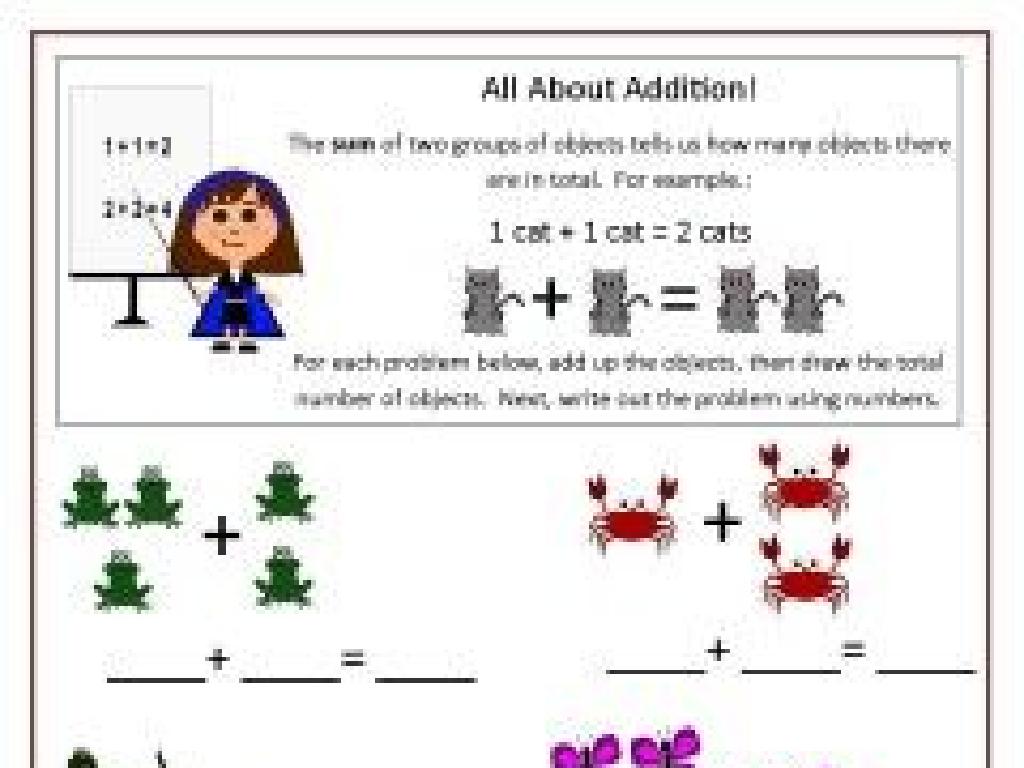Transversals Of Parallel Lines: Find Angle Measures
Subject: Math
Grade: Eighth grade
Topic: Lines And Angles
Please LOG IN to download the presentation. Access is available to registered users only.
View More Content
Transversals and Parallel Lines
– Exploring lines and angles
– Understand the basics of lines and their relationships.
– Defining parallel lines
– Lines that run side by side and never meet.
– Introducing transversals
– A line that crosses two or more lines.
– Intersecting lines and angles
|
This slide introduces the foundational concepts necessary for understanding how transversals interact with parallel lines. Begin by discussing the nature of lines and angles in general, ensuring students grasp the terminology. Then, define parallel lines as lines in the same plane that do not intersect, no matter how far they are extended. Introduce a transversal as a line that crosses at least two other lines, which could be parallel or not. Highlight that when a transversal intersects parallel lines, it creates several angles, which have special relationships that we will explore. Encourage students to visualize these concepts with diagrams and to consider real-world examples of parallel lines and transversals, such as railroad tracks and a crossing road.
Properties of Parallel Lines and Transversals
– Parallel lines remain equidistant
– Parallel lines never intersect
– Transversal creates angle pairs
– Corresponding, alternate interior, alternate exterior, and consecutive interior angles are formed.
– Calculating angles with transversals
– Use properties to find unknown angle measures.
|
This slide introduces the fundamental properties of parallel lines and the concept of a transversal in geometry. Emphasize that parallel lines, by definition, do not meet and are always the same distance apart. When a transversal cuts across parallel lines, it creates several types of angle pairs, each with unique properties. These include corresponding angles, alternate interior and exterior angles, and consecutive (or same-side) interior angles. Understanding these properties allows students to calculate unknown angles when given certain measurements. Provide examples of each angle type and demonstrate how to use the properties to solve for angles. Encourage students to practice by assigning problems that require them to apply these concepts.
Types of Angles in Parallel Lines
– Corresponding Angles
– Angles in matching corners when lines are cut by a transversal
– Alternate Interior Angles
– Angles inside parallel lines on opposite sides of the transversal
– Alternate Exterior Angles
– Angles outside parallel lines on opposite sides of the transversal
– Consecutive Interior Angles
– Angles inside parallel lines on the same side of the transversal
|
This slide introduces students to the types of angles formed when a transversal cuts through parallel lines. Corresponding angles are equal and are found in the same position at each intersection. Alternate interior angles are also equal and are located between the parallel lines but on opposite sides of the transversal. Alternate exterior angles, found outside the parallel lines, are equal as well. Consecutive interior angles, on the same side of the transversal and inside the parallel lines, are supplementary. Use diagrams to illustrate each type of angle, and provide examples for students to solve, reinforcing the concept that these angles have predictable relationships when the lines are parallel.
Angle Relationships in Parallel Lines and Transversals
– Parallel lines and transversals create angles
– Congruent angle pairs are formed
– Angles in the same position on parallel lines are equal
– Supplementary angle pairs appear
– Angles on one side of a transversal sum to 180°
– Exploring angle relationships with examples
– For example, alternate interior angles are congruent, and consecutive interior angles are supplementary
|
This slide introduces students to the concept of angle relationships when two parallel lines are intersected by a transversal. Emphasize the types of angles formed, such as corresponding, alternate interior, alternate exterior, and consecutive interior angles. Use diagrams to show congruent and supplementary angles. Provide examples for each type of angle pair, and encourage students to practice by finding measures of unknown angles in given figures. This foundational knowledge is crucial for solving problems involving parallel lines and transversals, and it will be applied in future geometry lessons.
Finding Angle Measures with Transversals
– Use properties of parallel lines
– When a transversal crosses parallel lines, angles are congruent or supplementary.
– Example: Find missing angles
– Given: Line l || Line m, transversal t intersects at angles 1 and 2. Find angle 2 if angle 1 = 50°.
– Step-by-step problem-solving
– Step 1: Identify angle relationships. Step 2: Apply properties to find unknowns.
– Practice with different angles
– Try finding angles when given alternate interior, corresponding, or consecutive angles.
|
This slide introduces students to the concept of finding unknown angle measures when a transversal intersects parallel lines. Emphasize the importance of understanding the properties of parallel lines and the angles formed by a transversal. The example problem should be solved step-by-step, demonstrating how to use angle relationships such as corresponding angles, alternate interior/exterior angles, and consecutive interior/exterior angles to find missing angle measures. Encourage students to practice with various angle types to solidify their understanding. Provide additional practice problems where students can apply these concepts to different scenarios.
Practice Problems: Finding Missing Angles
– Work through problems as a class
– Apply learned concepts on angles
– Use angle relationships like alternate interior, corresponding, and co-interior angles
– Find missing angles with transversals
– Example: If one angle is 120°, what are the alternate interior angles?
– Use equations to solve for angles
– Set up equations based on angle relationships to find unknown angles
|
This slide is designed for a collaborative classroom activity where students apply their knowledge of transversals and parallel lines to solve for missing angles. Start by solving a few problems together, demonstrating the process. Encourage students to identify angle relationships such as alternate interior, corresponding, and co-interior angles. Provide guidance on setting up equations to find unknown angles. For instance, if a transversal cuts two parallel lines and one angle is given, students should use the properties of parallel lines to find the measures of the remaining angles. Prepare to offer hints and facilitate discussion as students work through the problems. Have several practice problems ready, with varying levels of difficulty, to cater to all students.
Group Activity: Exploring Angles with Transversals
– Create parallel lines and a transversal
– Measure angles formed by the transversal
– Use a protractor to measure the angles accurately
– Calculate angles using angle relationships
– Apply properties of alternate, corresponding, and co-interior angles
– Discuss findings with the class
|
This class activity is designed to provide hands-on experience with the concept of transversals cutting through parallel lines. Students will work in groups to draw their own parallel lines and a transversal on paper or using string and a board. They will then use protractors to measure the angles formed. After measuring, students should calculate the angles using their knowledge of angle relationships such as alternate interior angles, corresponding angles, and co-interior angles. Once they have their measurements and calculations, each group will discuss their findings with the class, explaining the angle relationships they observed. This activity will help solidify their understanding of the geometric concepts and encourage collaborative learning. Provide guidance on how to use a protractor and ensure students understand the angle relationships before they begin. Prepare to facilitate the discussion by asking probing questions that lead to a deeper understanding of the topic.
Review: Transversals and Parallel Lines
– Recap transversals intersecting parallels
– Transversals create corresponding, alternate interior/exterior angles.
– Understand angle relationships
– Knowing these relationships helps solve for unknown angles.
– Significance in geometry
– Grasping these concepts is crucial for advanced geometry problems.
– Next: Angle Sum Property
– We’ll explore how the angles inside a triangle always add up to 180°.
|
This slide aims to consolidate the students’ understanding of the relationship between transversals and parallel lines. Emphasize the importance of recognizing corresponding and alternate angles, as this knowledge is key to solving complex geometry problems. Highlight how these angle relationships are foundational concepts that will be applied in future topics, such as the Angle Sum Property of Triangles. Prepare the students for the next class by hinting at how these concepts will be used to understand that the interior angles of a triangle sum up to 180 degrees, setting the stage for their continued learning in geometry.





